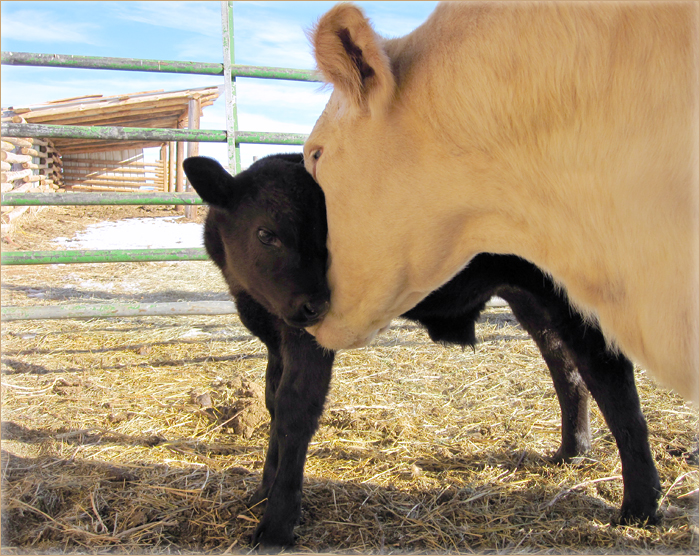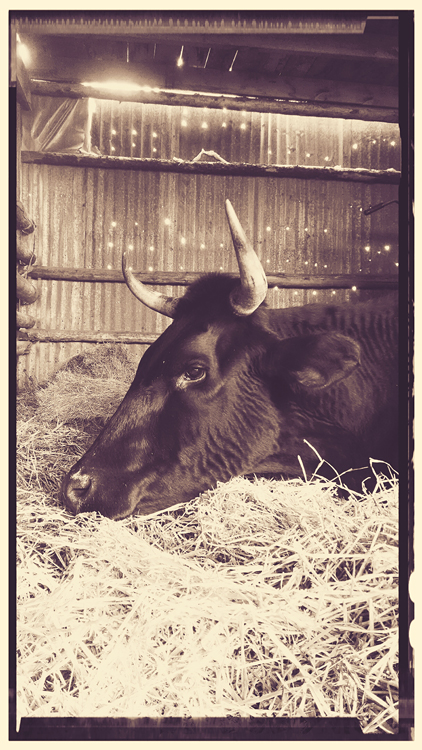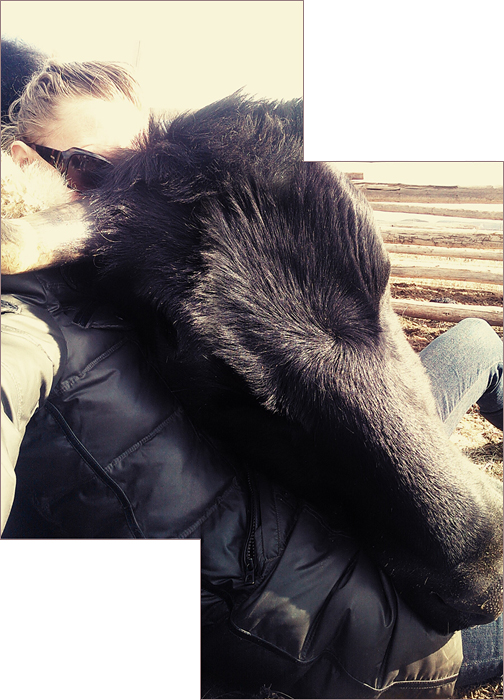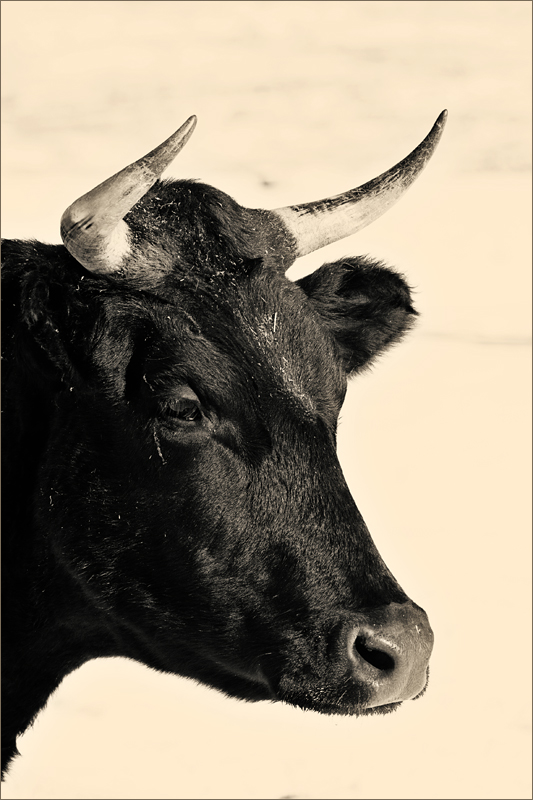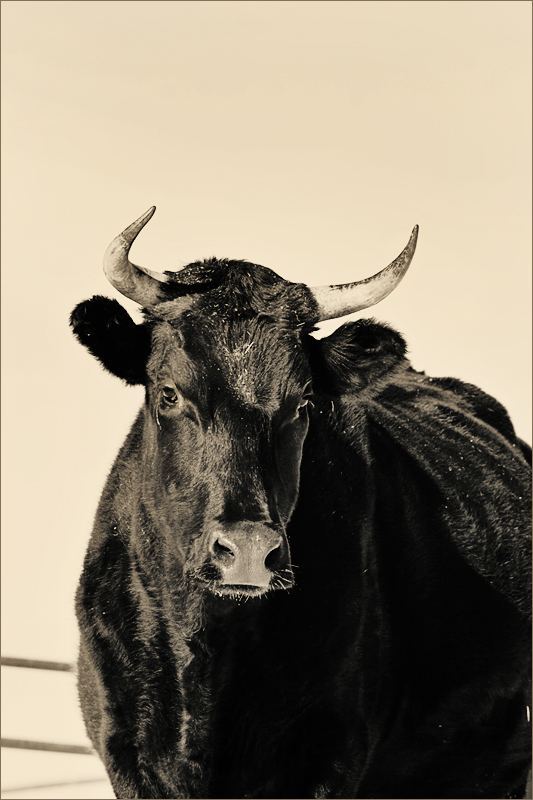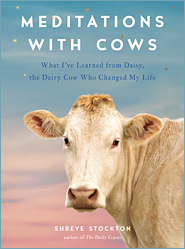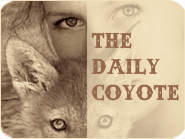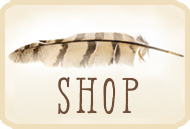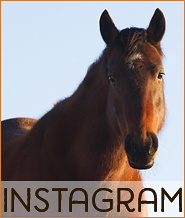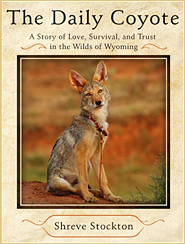Sliver
There’s half a moon already. I was surprised, last night, when I went outside at 10pm and it was bright enough to see easily, bright enough for hard-edged shadows. The moonlight bounced off Chloe’s white fur, making her glow. Charlie’s coat, which can magically camouflage itself in all seasons and environments – dry grass, snow, sagebrush, red dirt – blended with the night. His shadowy form sparkled as the white tips of his guard hairs caught the light.
Half a moon makes it easy to be outside in the dark – it’s light enough to walk around, no need for flashlights – yet still easy to sleep. Full moons disrupt – moonlight bounces off every stone, off each specular surface of our trucks, it magnifies, then seeps around the edges of curtains and slides across bedroom walls. My favorite moon is a sliver, a delicate crescent. I call it the Frisco moon and it makes me feel connected to him again, when I see it. His horns were that shape.
In the morning’s hush
Frisco
December 18, 2009 – April 4, 2014
Do not stand at my grave and weep,
I am not there; I do not sleep.
I am a thousand winds that blow,
I am the diamond glints on the snow,
I am the sunlight on ripened grain,
I am the gentle autumn rain.
When you awaken in the morning’s hush
I am the swift uplifting rush
Of quiet birds in circled flight.
I am the soft stars that shine at night.
Do not stand at my grave and cry,
I am not there; I did not die.
– Mary Elizabeth Frye
My Giant, My Heart
I’ve had this blog on a photo-intermission because Frisco has been very sick. About a month ago, my vet – whose general bedside manner is Mr. Happy-Go-Lucky – told me to prepare for the worst. He didn’t expect Frisco to make it another week. I’ve been pretty much living in the barn, and everything in my life that I could put on pause, I have. I’ve been so sad and so scared and so dirty, but it’s also been a special time, in a weird way. Tragedy incinerates everything that is not important.
We don’t know what has caused Frisco’s decline. He recovered from foot rot in January, then this ailment came on a few weeks later. Blood tests, fecal tests, organ tests have not shed much light nor given us any definite answers, and his treatment has been varied, including everything from antibiotics to flower essences to, most interestingly, a magnet. I fed Frisco a very large, very strong, pill-shaped magnet as a measure against Hardware Disease, which may or may not be at the root of his illness. Cattle are indiscriminate eaters, and if a small piece of metal or wire or a nail or fencing staple is littered in a pasture and then baled into hay, a cow may inadvertently eat it. Once swallowed, the metal can puncture the stomach wall, nearby organs, cause infection – basically, wreak havoc within. Eating a magnet can help remedy this: the magnet draws the metal out of the stomach tissue (as long as it is not aluminum) and holds the offending piece tightly against the magnet at the bottom of the stomach, where it remains (they don’t poop it out). The magnet will also catch any future metal the animal may ingest.
The past few mornings, Frisco has been eager to leave the barn and go out to eat at the hay bunk with Daisy and Fiona. His weight loss has been severe and is very frightening, yet his eyes and spirit are bright and lively. His appetite has improved, though he is still weak and wobbly. This afternoon I was down at the corrals, leaning against the fence, watching him. He ate some hay. He drank some water. He lay down in the sun. I went over and sat next to him, leaning back against his massive shoulder. I stroked his cheek, timed his pulse rate with my phone. He was tired. He closed his eyes. And then he swooped his head around, wrapped his neck around my body, laid his head on my chest, and fell asleep.
{I wish I had a go go gadget arm to have captured this scene from a distance! Alas. This image is two overlapping photos spliced together, hence the “missing” corners.}
A Spoonful Of Sugar
If you’ve never used a soup spoon to feed blackstrap molasses to a six-foot-tall, horned steer in the dead of winter, I highly recommend adding this to your bucket list. It is tricky: to fill a cold spoon with cold molasses; to navigate the spoon around the steer’s foot-long tongue and into his mouth; to dodge his sticky lips as he searches your face and torso for another spoonful. Both parties end up happy messes by the end of it.
It’s been unbelievably icy around here this winter. I wished I had crampons this morning just to cross the driveway to the chicken house. The snow drifts melt and puddle during the warm days, then it all re-freezes overnight. Ice upon ice upon ice. Some of the ice is smooth and slick, and some of it looks and feels like rough crumbles of glass. From this ice, Frisco got tiny cuts in the bottom of his feet, in the soft area around the actual hoof, and bacteria entered and caused an infection called foot rot. Foot rot is serious and painful, though not nearly as gross as the name implies. It’s fairly common in cattle, but this was my first first-hand experience with it. The infection caused swelling in both his hind ankles and made him lame – lameness, from the pain of the infection, is the most obvious early sign of foot rot. It can be knocked out with antibiotics, and cows have been known to fight the infection on their own, without medication, over the course of a couple of weeks, but a bad case can be fatal. This all started the last week of December, and it has been a battle.
The worst thing about doctoring large animals is the sheer volume of medicine one needs to administer in each dose. Giving a cat or a rooster a shot requires the tiniest syringe, a fine, delicate needle, and the act of giving the shot is over in a fraction of a second. Quick and painless, at least for the one administering the shot (ME!). With animals that weigh in well over 1000 pounds, it’s a very different story. Pills the size of a roll of quarters, syringes just as large. Giving a steer that is too tall to fit in the squeeze chute six giant pills and three giant shots multiple times a week is decidedly less fun than feeding him molasses with a spoon.
This bolus pusher helped me out with the pills. You put one pill in the tube at the end, then stick the apparatus into the beloved bovine’s mouth, guiding it in as far as you can and over the bump that cattle have at the back of their tongue, and then, with your third hand, push the plunger which gently deposits the pill so far back that they can’t spit it out and have to swallow it. Repeat six times. The pills annoyed Frisco, but at least they didn’t hurt. There’s just no gentle way to give a shot. Halfway through Frisco’s treatment, after I’d been dutifully cleaning the needles after each use, I came across a series of photos of a needle after reuse. I used fresh needles from then on, but I think it’s time I learned how to sharpen a needle.
While sick, Frisco lost his appetite and lost about 250 pounds with it. Just when I felt he had turned the corner and knocked out the infection, we got hit with serious cold and a few negative-20-degree nights. I stressed about his weakness and weight loss in such cold, but he and Daisy and Fiona slept together in the barn, and their body heat (which is substantial, and the original reason I started napping on cattle so many years ago) kept Frisco warm.
Yet Frisco needed to gain back some weight – and quickly. I was trying to think up some sort of high calorie mash I could give him, and landed on organic blackstrap molasses. I pretty much force-fed him by the spoonful the first day, but it did immediately stimulate his appetite for hay, and on the second day, he was like, “that stuff is delicious, do give me more.” The third day, I mixed the molasses with organic barley in a big pan. I don’t usually give my bovines grain, but Frisco desperately needed the calories, and this confection really helped him gain back his strength and his appetite. I gave him this treat once a day for a week or so, and now he’s getting it every other day. He’ll be bummed when this tapers off and his only treat is dried alfalfa pellets.
Friday morning, things were looking good. Frisco had a hearty appetite and dove into the breakfast hay alongside Daisy and Fiona. Around noon, I took Frisco his molasses treat and finally felt he was out of the woods. His personality was back in full force, and instead of losing weight daily, I could see he had started to gain some back. Hallelujah! I took my first full breath in two weeks, turned to Fiona, and my breath caught halfway down. Something was very, very wrong. She wasn’t showing signs of foot rot; she was showing signs of labor. I spent the afternoon and evening at the corral, and at dusk, Fiona miscarried. I think the only thing worse than midwifing a miscarriage would be having one. I really don’t have anything else to say on it. If you’ve been through it, you know; if you haven’t, words can’t possibly approach it.
This story actually ends on a high note, beyond Frisco and Fiona remaining alive and on the mend. My vet came by on Saturday because Fiona had not birthed the placenta (apparently, it can take up to a week with cows with preterm calves; he made sure she wasn’t carrying twins and gave her some shots to help the process). After he attended to Fiona, I asked him to preg test Daisy. Daisy’s last calf was born in July 2012. It was a treacherous birth, extremely hard on Daisy and the calf did not survive. We got Maia, an orphan calf, for Daisy to adopt (and Maia is now all grown up and pregnant herself!) but Daisy has not bred back since. I’ve had her preg checked a few times during the last 18 months but can’t even remember the last time – late spring or early summer – and on Saturday, I had zero expectations, even though I’d not seen Daisy and Sir Baby “courting” since October. But since the vet was here, and Daisy was underfoot, why not?
When the vet said, “90 days,” I thought he meant no dice, and that he’d check her again in 90 days. I think he had to repeat himself three times for it to finally register, and when it did, I wept. She’s 90 days bred! If all continues to go well, she’ll calve mid-July. After nearly two years, and wondering if Daisy would ever be able to get pregnant again, this news was the sweetest sugar that helped soothe the sadness.
Big Love
Frisco is now taller than a horse,
his horns are now thicker than my forearm at the base,
but he still has such a baby face.
And, like a baby,
he likes to rub his face in his food before eating it.
That’s hay all over his forehead.
